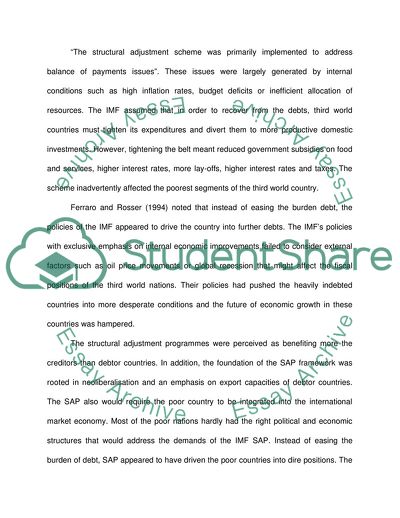Cite this document
(IMF Structural Adjustment Program Term Paper Example | Topics and Well Written Essays - 1500 words, n.d.)
IMF Structural Adjustment Program Term Paper Example | Topics and Well Written Essays - 1500 words. https://studentshare.org/finance-accounting/1706837-discuss-the-nature-and-aims-of-imfs-stuctural-adjustment-programme-and-whether-their-impact-on-economic-and-social-conditions-of-developing-countres-has-been-p
IMF Structural Adjustment Program Term Paper Example | Topics and Well Written Essays - 1500 words. https://studentshare.org/finance-accounting/1706837-discuss-the-nature-and-aims-of-imfs-stuctural-adjustment-programme-and-whether-their-impact-on-economic-and-social-conditions-of-developing-countres-has-been-p
(IMF Structural Adjustment Program Term Paper Example | Topics and Well Written Essays - 1500 Words)
IMF Structural Adjustment Program Term Paper Example | Topics and Well Written Essays - 1500 Words. https://studentshare.org/finance-accounting/1706837-discuss-the-nature-and-aims-of-imfs-stuctural-adjustment-programme-and-whether-their-impact-on-economic-and-social-conditions-of-developing-countres-has-been-p.
IMF Structural Adjustment Program Term Paper Example | Topics and Well Written Essays - 1500 Words. https://studentshare.org/finance-accounting/1706837-discuss-the-nature-and-aims-of-imfs-stuctural-adjustment-programme-and-whether-their-impact-on-economic-and-social-conditions-of-developing-countres-has-been-p.
“IMF Structural Adjustment Program Term Paper Example | Topics and Well Written Essays - 1500 Words”. https://studentshare.org/finance-accounting/1706837-discuss-the-nature-and-aims-of-imfs-stuctural-adjustment-programme-and-whether-their-impact-on-economic-and-social-conditions-of-developing-countres-has-been-p.


